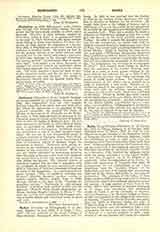

Backx, PETER HUBERT EVERMODE, b. December 10, 1805, at Tilburg, Holland; d. October 28, 1868. Ordained priest March 17, 1832, he may be considered the second founder of the Norbertine Abbey of Tongerloo (Province of Antwerp, Belgium), which was established in 1128, or eight years after the foundation of the Premonstratensian Order by St. Norbert. It had to suffer much from the Protestants during the second half of the sixteenth century, but the fatal blow was struck by the French Republic, which, on December 6, 1796, expelled the religious, confiscated the abbey, and sold it to the highest bidder. At that time Tongerloo was at the heighth of its prosperity. After the suppression of the Jesuits, the abbot and community of Tongerloo had made all arrangements for the continuation of the “Acta Sanctorum” and the “Analecta Belgica” of the Bollandists, and four of its canons were cooperating with two of the former Bollandists in this gigantic publication. The catalogue of the Abbey of Tongerloo, made in 1796, gives the names of one hundred and nineteen priests and professed scholastics and of six novices. A large number of these lived in the abbey, others were attached to parishes belonging to it. Some were completing their theological studies in Rome or at the University of Louvain, one was President of St. Norbert’s College in Rome, another was president of the college of the same name at Louvain. Under the French Republic and again, after the battle of Waterloo, during the reign of William I, King of the Netherlands, the expelled and dispersed religious were not allowed to form a new community, but better times came with the creation of Belgium as a separate kingdom, in 1830. Only sixteen of the one hundred and twenty-five religious were living at that time and nearly all were well advanced in years. The castle of Halmale near Antwerp was rented, and the first novice, Peter Hubert Backx, received the white habit and with it the name in religion of Evermode. Three more young priests and others who had finished their classical studies followed his example. In 1839 Evermode Backx was chosen superior of the revived community.
At the death of one of the proprietors one-half of the dilapidated Abbey of Tongerloo was bought at a public auction and Abbot Backx led, amidst the rejoicings of the villagers, the young community to Tongerloo, July 1, 1840. That very afternoon, the Divine Office was resumed with the first Vespers of the Feast of Our Lady’s Visitation. On the following day, the venerable Chrysostom Raemakers, who had celebrated the last Mass on the day of the suppression, December 6, 1796, sang a solemn Mass in one of the rooms improvised as a temporary oratory, the abbey church and other buildings having been pulled down.
Evermode Backx’s first work was to repair what was left of the former abbey and to erect new buildings for the growing community. In 1849 the second part of the confiscated abbey was bought and in 1852 the first stone of a large church was solemnly laid by the papal nuncio, so that the abbey began to have the appearance of a large and well-ordained monastery. After a strenuous government of twenty-eight years Evermode Backx died, regretted by his spiritual children. The work was carried on with equal zeal by his successors, the Right Rev. Abbot Chrysostom De Swert (d. 1887) who sent some of his religious to found the priories of Crowle and Spalding, England; the Right Rev. Thomas Heylen, afterwards Bishop of Namur, Belgium, the founder of Corpus Christi Priory, Manchester, and of the Norbertine missions in the Independent State of Congo, Africa; and the Right Rev. Adrian Deckers, formerly Prefect Apostolic in the Congo. The catalogue of the Abbey of Tongerloo for 1907 gives the names of 78 priests, 8 professed scholastics, 4 novices, and 23 lay brothers, or a total of 113 religious, several of whom are engaged in parish work, 14 working in England, and 16 in the Congo missions.
THOMAS F. MEEHAN

